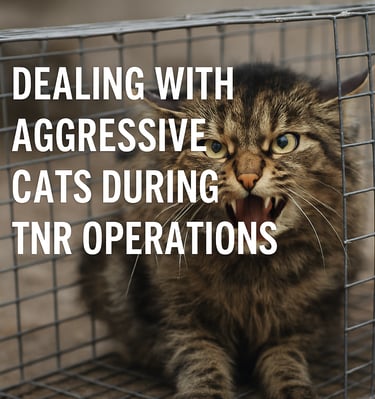Understanding Aggression in Feral and Stray Cats
Aggression is usually rooted in fear. Feral cats, unlike pet cats, are not socialized to humans. They see human contact as a threat and act out of instinct to protect themselves. Even some stray or abandoned cats—especially those traumatized—may show signs of aggression during TNR operations.
There are several types of feline aggression you might encounter:
Fear-based aggression: Common in feral cats unfamiliar with human presence.
Territorial aggression: Cats may defend their space from intruding humans or other cats.
Pain-induced aggression: An injured or sick cat may lash out when touched or approached.
Recognizing these behaviors can help you tailor your approach during spay and neuter efforts.
Dealing with Aggressive Cats During TNR Operations
When implementing a Trap-Neuter-Return (TNR) program, volunteers and caregivers often encounter challenges—one of the most daunting being how to handle aggressive cats. These cats may hiss, scratch, or bite in fear and defense, especially during trapping or recovery. Understanding the causes of this aggression and learning humane strategies to manage it can make a big difference in the success of your TNR efforts.
Whether you're a seasoned volunteer or new to the process, this guide will help you safely and effectively manage aggressive felines while continuing your commitment to community cat help in Cattaraugus County and beyond.


Preparing for Aggressive Cats in TNR Programs
Preparation is key when working with cats that may behave aggressively. Here’s what you can do before stepping into the field:
1. Use Proper Equipment
Always use humane box traps designed for feral cat rescue. Avoid using hands or towels to capture or restrain aggressive cats. Heavy-duty gloves, trap dividers, and transfer cages are essential tools for your safety.
2. Plan the Trap Site Strategically
Choose quiet, low-traffic areas for trapping. Loud noises or sudden movements can stress cats further. Hide traps behind bushes or use camouflage covers to keep cats calm.
3. Use Food as Motivation, Not Bait
While food lures are effective, avoid letting cats eat directly in the trap before it’s set. Hungry cats are more likely to enter the trap without suspicion.
Handling Aggressive Cats Safely
Once the cat is trapped, managing it without injury to either party is crucial:
1. Minimize Human Interaction
Don’t attempt to pet or comfort the cat. Keep trap covers over the trap to reduce visual stimuli and keep the cat calm.
2. Avoid Eye Contact
Direct staring can be seen as a threat. Instead, quietly monitor the cat from the side or through a camera if available.
3. Use Trap Dividers
When transporting or treating cats, use a trap divider to safely isolate the cat in one section of the trap. This allows for cleaning or adding food without physical contact.
Spay and Neuter Procedures for Aggressive Cats
Veterinarians who work with TNR programs understand the challenges of dealing with fearful or aggressive cats. Most use anesthesia while the cat is still in the trap to ensure safe handling.
Benefits of Spay and Neuter for Aggressive Cats:
Reduces aggression caused by hormones or mating behaviors.
Lowers stress levels over time, especially in males.
Prevents future feral kittens, reducing the overall feral population and easing the burden on volunteers and shelters.
In Cattaraugus County, low-cost veterinary care is available through various clinics that support humane stray cat control, making it easier to manage large-scale TNR operations.
Aftercare and Release Tips
After surgery, recovery should take place in a secure, quiet location. Aggressive cats may still be defensive during this stage.
Keep the cat in the trap during recovery to avoid injury.
Feed and observe without direct contact.
Return the cat to its original territory once fully recovered.
Returning cats to familiar areas helps reduce stress and territorial disputes with other cats.
Building Experience and Confidence
Handling aggressive cats is a skill that improves with time and training. If you're new to TNR:
Shadow experienced volunteers.
Watch online tutorials about safe handling.
Join local TNR workshops or webinars.
Your work as a volunteer is essential to the health and safety of both cats and your community. Don’t hesitate to ask for support from organizations like Catt County Cat Nippers, which is actively involved in community cat help across Cattaraugus County.
Final Thoughts
Dealing with aggressive cats during TNR operations may be intimidating at first, but it’s a manageable and necessary part of protecting feral cats and reducing overpopulation. With patience, the right tools, and humane practices, you can safely help even the most defensive felines.
TNR programs, especially when supported by compassionate community members and low-cost veterinary care, are a vital piece of the puzzle for humane stray cat control. Every aggressive cat that’s successfully spayed or neutered is one step closer to a healthier, safer community for cats and humans alike.
CATT COUNTY CAT NIPPERS

"I can't say enough good things about Catt County Cat Nippers. They helped a stray mother cat and her kittens in my neighborhood when no one else would. The volunteers were so kind and professional. Our community is better because of them."
Emily R., Local Resident

"Thanks to this amazing group, I found my best friend — a rescue cat named Oliver. The adoption process was smooth, and they really care about matching cats with the right homes. You can tell they love what they do."
Jason L., Cat Adopter


★★★★★
★★★★★
Subscribe to our website
Contact us :
Quick links :
Contact Us
© 2025 CATT COUNTY CAT NIPPERS All rights reserved.
